Publication Details |
| Category | Text Publication |
| Reference Category | Journals |
| DOI | 10.1093/femsec/fiy012 |
| Title (Primary) | Anaerobic microbial dehalogenation and its key players in the contaminated Bitterfeld-Wolfen megasite |
| Author | Nijenhuis, I.; Stollberg, R.; Lechner, U. |
| Source Titel | FEMS Microbiology Ecology |
| Year | 2018 |
| Department | ISOBIO; ENVINF |
| Volume | 94 |
| Issue | 4 |
| Page From | fiy012 |
| Language | englisch |
| Keywords | in situ, organohalide biotransformation, reductive dechlorination, Dehalococcoides, monochlorobenzene, chlorinated ethenes, chlorinated dibenzo-p-dioxins |
| UFZ wide themes | RU3; |
| Abstract | The megasite Bitterfeld-Wolfen is highly contaminated as a result of accidents and because of dumping of wastes from local chemical industries in the last century. A variety of contaminants including chlorinated ethenes and benzenes, hexachlorohexanes and chlorinated dioxins can still be found in the groundwater and (river) sediments. Investigations of the in situ microbial transformation of organohalides have been performed only over the last two decades at this megasite. In this review, we summarise the research on the activity of anaerobic dehalogenating bacteria at the field site in Bitterfeld-Wolfen, focusing on chlorinated ethenes, monochlorobenzene and chlorinated dioxins. Various methods and concepts were applied including ex situ cultivation and isolation, and in situ analysis of hydrochemical parameters, compound-specific stable isotope analysis of contaminants, 13C-tracer studies and molecular markers. Overall, biotransformation of organohalides is ongoing at the field site and Dehalococcoides mccartyi species play an important role in the detoxification process in the Bitterfeld-Wolfen region. |
| Persistent UFZ Identifier | https://www.ufz.de/index.php?en=20939&ufzPublicationIdentifier=20222 |
| Nijenhuis, I., Stollberg, R., Lechner, U. (2018): Anaerobic microbial dehalogenation and its key players in the contaminated Bitterfeld-Wolfen megasite FEMS Microbiol. Ecol. 94 (4), fiy012 10.1093/femsec/fiy012 |
|
